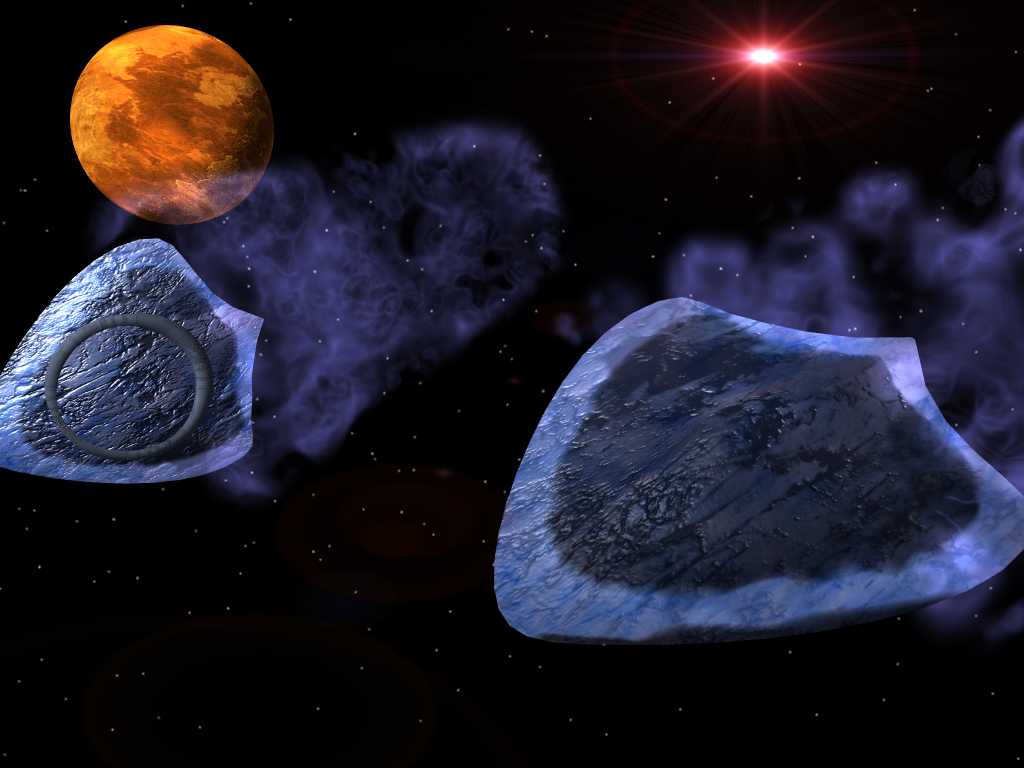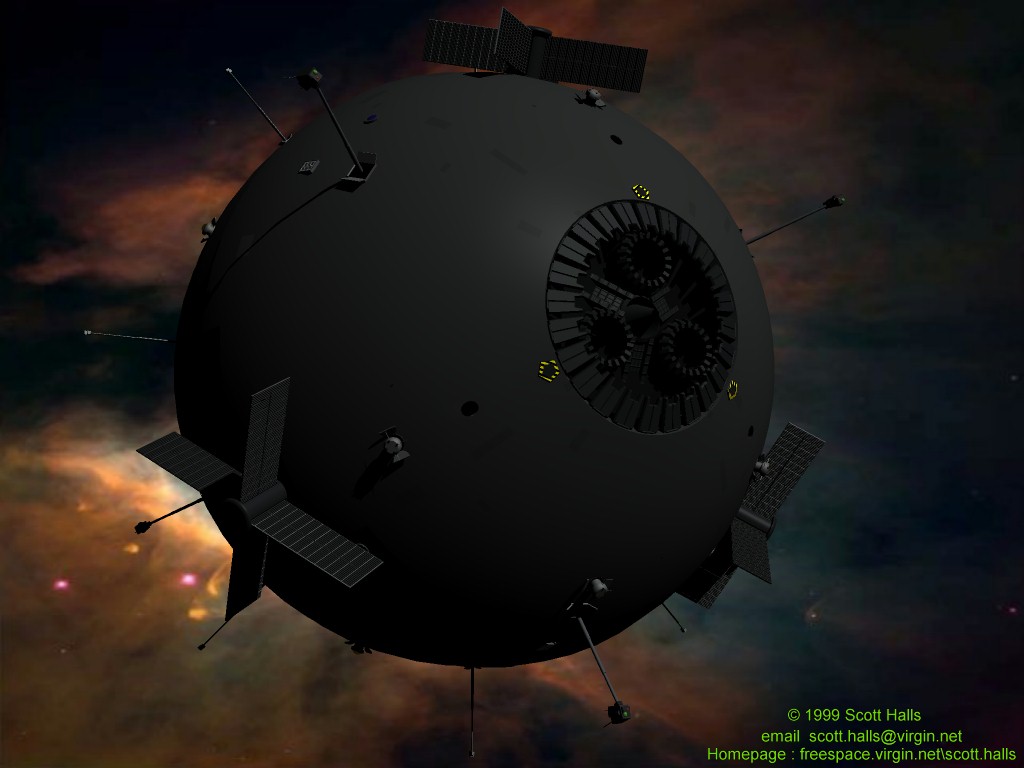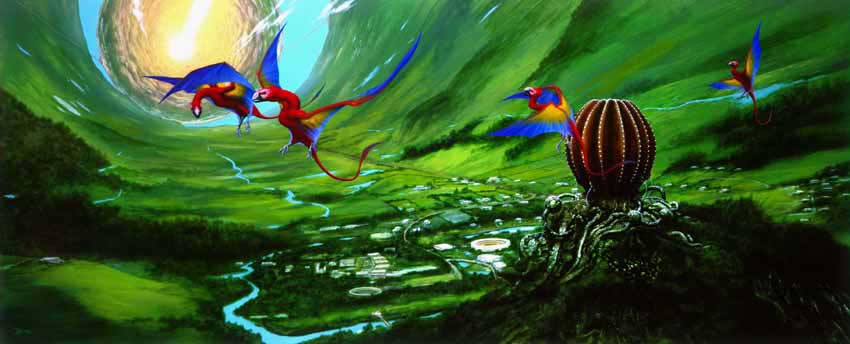The Night's Dawn
Trilogy
By Peter F. Hamilton
Home Page |
Background
Information |
Summary | Main
Characters | SF Themes
Biography/Other Works |
Critical Reviews | Sources
The Night’s Dawn trilogy has many characteristics of a classic space opera: plenty of fighting with futuristic weapons, “space zombies” returning to life and attacking the living, and exotic alien environments, but there is more to this series than flashy fight scenes and sleek spaceships. TND deals in depth with many themes of classic hard SF, as well as developing metaphysical and ethical concepts. The key themes that make The Night’s Dawn more than just an entertaining read and lift it above mere space operas are discussed below.
SF Themes
Space Craft/FTL Travel |
Space Combat | AI | Biotech
Religion/Afterlife | Environment
| Utopias/Dystopias
Space Craft and Faster Than Light Travel: The Night’s Dawn series exhibits two principle starship types, each in possession of a way to safely and quickly traverse astronomical distances. Hamilton describes the operations of both types very precisely in the novels.
-
Edenists voidhawks are organic and fully conscious space craft that reproduce sexually. They are able to create worm hole-like tears in time-space, called voids, through which they can traverse great distances nearly instantaneously. Voidhawks are able to calculate safe routes of passage as a matter of instinct, so many jumps can be made in a very short amount of time.

Adamist starships are mechanical and uniformly spherical
due to the requirements of the ZTT drive that allows for nearly
instantaneous spatial travel. The crew use neural nanonics (see the “Artificial
Intelligence” section below) to control their ships just by thinking the
proper commands.
Navigation Bar
Space Combat:
The primary weapon of space combat in TND is the combat wasp. These
are versatile self propelled devices that are launched from space craft and
can be programmed for defensive operations, such as electromagnetic
interference, or offensive operations, such as acting as a simple homing
missile.
Navigation Bar
-
Edenist bitek constructs (see the “Biotechnology” section below)
-
Neural nanonics are extremely small computer systems that integrate with their hosts’ central nervous systems. They provide a wide variety of services to their owners (almost always Adamists) such as easily accessible memory storage, astro-navigation, and control of physical stimuli and the body’s chemical levels.
-
There are no true robots seen in TND, but as exhibited by neural nanonics, artificial items are integrated into human bodies quite frequently. The most striking expamples of this are mercenaries, who commonly have their organs replaced with more durable artificial analogues and their limbs replaced with weapons. Career space workers will often have their brains removed from their organic bodies and integrated into mechanical constructs that allow them to be exposed to vacuum without the aid of space suits.
Navigation Bar
-
Edenist bitek constructs: The Edenists utilize biotechnology to create living creatures to serve many of their needs
-
Edenist habitats are organic and fully conscious entities that serve as space stations. They grow from infancy as a small polyp into creatures many kilometers in diameter. Their insides are hollow and possess gravity and breathable atmospheres. Habitats can live for several hundred years, but like all organic creatures they eventually age and die.
-
For information on Edenist voidhawks see the above section “Space Vessels and Faster that Light Travel.”
-
-
Affinity bonds are organic neural transmitters/receivers that can be inherited or implanted. They allow their owners (human, voidhawk, or habitat) to communicate with one another telepathically and empathically.
-
Geneering (genetic engineering) was widely used several hundred years before the events of TND take place. These procedures improved on their owners’ bodies in ways such as enhancing their immune systems, strengthening muscles and bones, and improving cosmetic appearance. These traits are inherited, so most characters in TND are beneficiaries of their ancestors’ procedures.
Navigation Bar
Religion and Afterlife: Religion and afterlife
are key concepts in TND: the primary focus of the series is the
Possessed that are returning to the physical universe from an afterlife
called the Beyond, which calls into question the validity of traditional
Judeo-Christian beliefs still held by much of the Adamist population (the
Edenists having already rejected religion). Hamilton suggests that humans
have a “soul” in the form of energy thought patterns that develop from
peoples’ physical thought patterns during life. Upon death, the energy
copies of these thought patterns continue to exist and can enter into one of
two realms of existence, the apogee of the universe, in which all of time
culminates into infinity, or the Beyond, in which “souls” that are not
prepared to abandon the physical realm are still able to observe the
universe in which they lived. Existence in the Beyond is torturous because
the “souls” are constantly striving for physical sensation that they cannot
have in their non-physical void and are fully and painfully aware of the time that passes.
Navigation Bar
Environment: Human attempts to change their environments, or accidental changes to their environments, are frequent in the TND universe.
-
Terraforming: Lalonde is a planet undergoing the process of terraforming. Its atmosphere was changed prior to colonization so that humans could live inside the biosphere. Private enterprises are responsible for the terraforming and colonization of planets and, as seen in the case of Lalonde, generally use a low-tech and cost effective method that requires a great deal of manual human labor for the first several decades in order to create a foothold for humanity on the planets and eventually achieve industrialization.
-
Possessed Initiated Planetary Change: When enough Possessed are present on a planet, they often use their ability to manipulate energy to remove the entire world from the physical universe so that there is no space outside of the atmosphere. They do this because they all have developed phobias of open space while in the void of the Beyond. They attempt to change these planets into utopias, but are ultimately unsuccessful. (See below for information regarding utopias and dystopias in TND.)
-
Space Stations and Habitats:
-
Adamists create space stations by maneuvering asteroids into a planetary orbit and boring tunnels into them that are later flooded with a breathable atmosphere.
-
Habitiats: See the information regarding Edenist Habitats in the Bio-tech section.
-
-
Pollution: By the time of the events of TND, Earth’s atmosphere is no longer able to sustain life and massive storms cover the planet due to pollution from human industrial activities. Large domes were created around cities so that humans could continue to inhabit the planet, and food and other organic materials are imported from off world.
Navigation Bar
-
The Edenists have created a true utopian society (as suggested by the name). Their affinity bonds allow for very healthy social integration because everyone’s thoughts and feelings are open books to the rest of the population; this leads to very few incidents of social deviance. Edenist habitats are the ideal human environment, designed with all the pleasant aspects of nature but none of its dangers or annoyances. There is no sickness amongst the population, and the average life span is greater than 150 years due to their level of medical technology and geneered bodies.

-
As stated above, the Possessed remove planets they control from the physical universe in order to escape the great emptiness of outer space that reminds them of the void of the Beyond. In addition to relocating the planet, they use their energy manipulation powers to idealize the weather and living conditions. No one is supposed to have to do labor in order to eat because they believe they can sustain their bodies through energy manipulation. As time goes on, however, it becomes obvious that the physical substance of the planets is being destroyed because the fundamental laws of physics do not apply in their new universes, and the Possessed find that under the cosmetic illusions of their former bodies that they have created, the actual bodies they inhabit are malnourished and near death. In attempting to create utopias, the Possessed actually build dystopias.
-
When the Possessed leader Kiera Saltar gains control of the bitek habitat Valisk she initiates a propaganda campaign in which the habitat is portrayed as a utopia to discouraged and underprivileged youths. Those that are fooled by the propaganda and seek out the supposed utopia are immediately possessed, realizing too late that their supposed utopia is false.
Navigation Bar